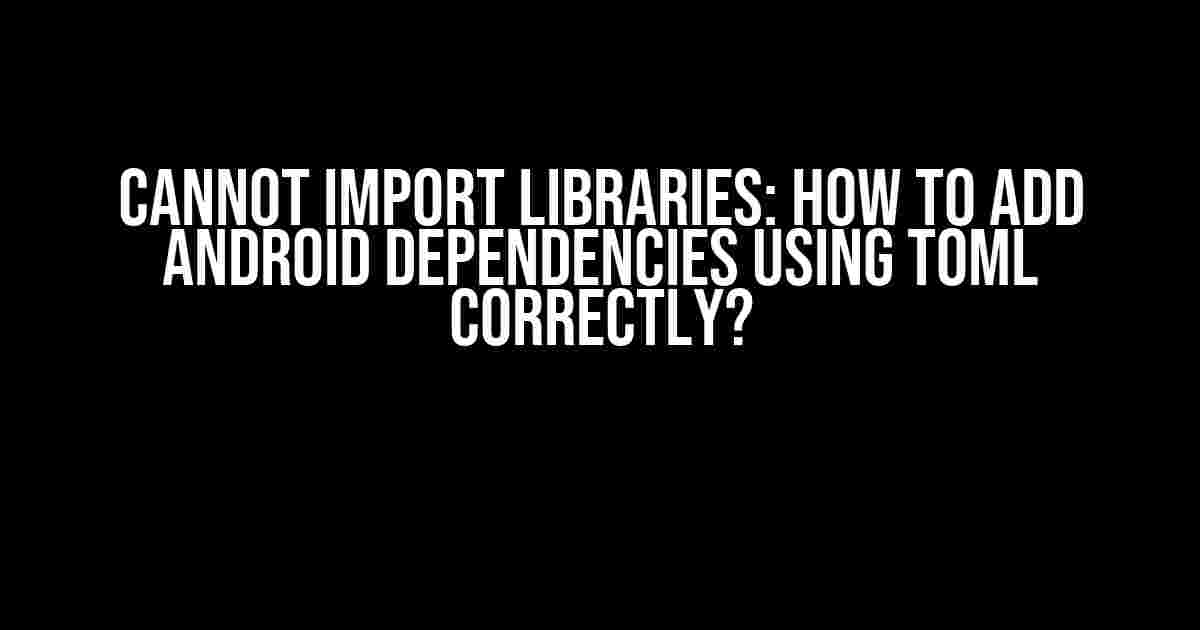Are you tired of struggling with Android dependencies and Tom’s Obvious, Minimal Language (TOML)? Do you find yourself stuck with the infamous “Cannot import libraries” error? Fear not, dear developer, for we’ve got you covered! In this comprehensive guide, we’ll walk you through the process of adding Android dependencies using TOML, so you can finally get back to building that amazing app you’ve been dreaming of.
What is TOML?
Before we dive into the nitty-gritty of adding dependencies, let’s take a quick moment to understand what TOML is. TOML is a lightweight, easy-to-read configuration file format that’s gained popularity in the Android development community. It’s used to manage project dependencies, plugins, and other configuration settings.
Why Use TOML for Android Dependencies?
- Simplified dependency management**: TOML makes it easy to manage your project’s dependencies, eliminating the need for lengthy Gradle scripts.
- Faster build times**: By using TOML, you can reduce your build times, allowing you to focus on what really matters – building an awesome app!
- Improved code organization**: TOML promotes clean and organized code, making it easier to maintain and update your project.
Preparing Your Android Project for TOML
Before you start adding dependencies, make sure your Android project is set up to use TOML. Follow these steps:
- Open your Android project in Android Studio.
- Go to
File>Settings(orPreferenceson Mac). - In the
Settingswindow, navigate toGradle>Experimental. - Check the box next to
Enable TOML-based dependency declarations. - Click
Applyand thenOKto save your changes.
Creating a TOML File
Now that your project is set up to use TOML, create a new file called dependencies.toml in the root directory of your project. This file will contain all your project’s dependencies.
[dependencies]
Adding Android Dependencies Using TOML
It’s time to add some dependencies! In this example, we’ll add the popular Retrofit library to our project.
[dependencies] retrofit = "com.squareup.retrofit2:retrofit:2.9.0"
In this example, we’ve added Retrofit version 2.9.0 to our project. You can add more dependencies by separating them with commas or new lines.
[dependencies] retrofit = "com.squareup.retrofit2:retrofit:2.9.0" okhttp = "com.squareup.okhttp3:okhttp:4.9.0" gson = "com.google.code.gson:gson:2.8.6"
Common TOML Dependency Formats
When adding dependencies, you’ll often encounter different formats. Here are a few common ones:
| Format | Description |
|---|---|
groupId:artifactId:version |
Used for Maven-style dependencies (e.g., Retrofit). |
groupId:artifactId:classifier:version |
Used for Maven-style dependencies with classifiers (e.g., Javadoc or sources). |
implementation 'groupId:artifactId:version' |
Used for Gradle-style dependencies. |
Syncing Your TOML File with Gradle
Now that you’ve added your dependencies to the TOML file, it’s time to sync them with Gradle. Follow these steps:
- Open the
build.gradlefile in your project. - Delete the entire
dependenciesblock. - Add the following line to the top of the file:
// build.gradle apply plugin: 'com.android.application' apply plugin: 'com.gradle.toml.dependencies'
This line tells Gradle to use the TOML file for dependency management.
Troubleshooting Common Issues
If you encounter issues while using TOML for Android dependencies, here are some common solutions:
- Cannot find dependency**: Double-check the dependency format and version. Make sure you’ve added the correct repository to your
build.gradlefile. - Dependency conflict**: Check for conflicting dependencies by running
./gradlew dependencies. Use theexcludekeyword to resolve conflicts. - TOML file not recognized**: Ensure your TOML file is named correctly (
dependencies.toml) and is located in the root directory of your project.
Conclusion
Adding Android dependencies using TOML might seem daunting at first, but with this comprehensive guide, you should now be able to manage your project’s dependencies with ease. Remember to keep your TOML file organized, sync it with Gradle, and troubleshoot any issues that arise. Happy coding!
By following these steps and best practices, you’ll be well on your way to becoming a TOML master and creating amazing Android apps in no time!
Frequently Asked Question
Get the answers to your burning questions about adding Android dependencies using TOML correctly!
What is the correct way to add Android dependencies in a TOML file?
To add Android dependencies in a TOML file, you need to specify the dependencies in the `[dependencies]` section of your ` Cargo.toml` file. For example, to add the Android SDK, you would add the following lines: `[dependencies.android] gradle = “com.android.tools.build:gradle:4.1.0″` and `[dependencies.androidx] core = “androidx.core:core-ktx:1.6.0″`.
How do I specify the version of a dependency in TOML?
To specify the version of a dependency in TOML, you can add the version number after the package name, separated by a colon. For example, to add version 1.6.0 of the AndroidX Core library, you would add the following line: `[dependencies.androidx] core = “androidx.core:core-ktx:1.6.0″`.
Can I use semantic versioning in TOML dependencies?
Yes, you can use semantic versioning in TOML dependencies. For example, you can specify a range of versions using the tilde (~) or caret (^) symbols. For example, to specify any version of the AndroidX Core library greater than or equal to 1.6.0, you would add the following line: `[dependencies.androidx] core = “androidx.core:core-ktx:~1.6.0″`.
How do I add multiple dependencies in TOML?
To add multiple dependencies in TOML, you can list each dependency on a separate line within the `[dependencies]` section. For example, to add both the Android SDK and the AndroidX Core library, you would add the following lines: `[dependencies.android] gradle = “com.android.tools.build:gradle:4.1.0″` and `[dependencies.androidx] core = “androidx.core:core-ktx:1.6.0″`.
What happens if I forget to add a dependency in TOML?
If you forget to add a dependency in TOML, your Android project will not compile. The build process will fail, and you will see an error message indicating that the dependency is missing. To fix this, simply add the missing dependency to the `[dependencies]` section of your `Cargo.toml` file and rebuild your project.

